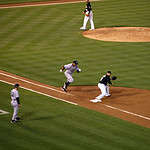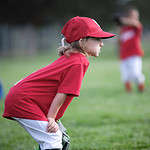Quality at-bats, or QABs, have become an increasingly popular metric in baseball for evaluating a batter’s performance. While traditional statistics like batting average and home runs are still widely used, QABs take into account a batter’s ability to execute certain actions at the plate that can help their team win games.
QABs are defined as plate appearances in which a batter does one of the following: sees at least five pitches, hits a sacrifice fly or bunt, works a walk, or gets a hit. These actions are considered to be valuable because they can help a team by wearing down a pitcher, advancing runners, or simply putting the ball in play. QABs are also useful for evaluating a player’s consistency and ability to contribute to their team’s success even if they aren’t hitting for a high average or hitting a lot of home runs.
While QABs are still a relatively new concept, they have gained traction in recent years as teams and analysts look for new ways to evaluate players. Some teams even use QABs as a factor in determining playing time or contract negotiations. As the importance of QABs continues to grow, it’s likely that they will become a more widely accepted and integrated part of baseball analytics.

Understanding QABs
Definition of QAB
Quality At-Bats (QABs) is a baseball statistic used to measure a player’s ability to have a successful at-bat. A successful at-bat is one in which a batter reaches base or advances a runner. QABs are a way to measure a player’s ability to contribute to the team’s success, even if they don’t get a hit.
Quality At-Bat Vs Plate Appearance
A Quality At-Bat is different from a Plate Appearance. A Plate Appearance is any time a player goes to the plate to bat. A Quality At-Bat is a Plate Appearance that meets certain criteria. A Quality At-Bat is one of the following:
- A plate appearance that results in a walk
- A plate appearance that results in a hit
- A plate appearance that results in a sacrifice fly
- A plate appearance that results in a sacrifice bunt
- A plate appearance that lasts at least six pitches
QAB Percentage Calculation
QAB Percentage is the percentage of a player’s Plate Appearances that result in a Quality At-Bat. QAB Percentage is calculated by dividing the number of Quality At-Bats by the total number of Plate Appearances and multiplying by 100.
QAB Percentage = (Number of Quality At-Bats / Total Number of Plate Appearances) x 100
QAB Percentage can be used to compare players’ abilities to have Quality At-Bats. A higher QAB Percentage indicates a player who is more likely to contribute to the team’s success.
In conclusion, QABs are a valuable statistic in baseball that measures a player’s ability to have a successful at-bat. By understanding the definition of QABs, the difference between Quality At-Bats and Plate Appearances, and how to calculate QAB Percentage, fans can gain a deeper appreciation for a player’s contribution to the team’s success.
Importance of QABs in Baseball
Role in Scoring Position
Quality at-bats (QABs) are an essential component of baseball. They refer to an at-bat in which the batter works the count, sees a lot of pitches, and does not make an out. QABs are crucial in moving runners into scoring positions. When a batter has a QAB, it means they have done their job by not making an out and allowing the next batter to drive in a run.
Impact on Batting Average
QABs also have a significant impact on a player’s batting average. Players who focus on quality at-bats are more likely to have a higher batting average than those who do not. This is because they are not making outs as frequently and are more likely to get on base.
Influence on Team’s Success
A team’s success is heavily influenced by the QABs of its players. When players are focused on quality at-bats, they are more likely to get on base, move runners over, and score runs. This, in turn, leads to more wins for the team.
In conclusion, QABs play a crucial role in baseball. They help move runners into scoring positions, improve a player’s batting average, and contribute to a team’s success. Players who focus on quality at-bats are more likely to be successful and help their team win.

| Entity | Relevance |
|---|---|
| Scoring Position | QABs help move runners into scoring position |
| Batting Average | QABs improve a player’s batting average |
| Team | QABs contribute to a team’s success |
| Win | QABs help a team win |
Key Elements of a QAB
Walks
Walks are an important part of a Quality At-Bat (QAB). They occur when a batter receives four balls from the pitcher without swinging at any of them. Walks are a sign of a batter’s patience and discipline at the plate. A walk can be a valuable way to get on base, especially if the batter has a high on-base percentage.
Hits
Hits are another essential element of a QAB. A hit occurs when a batter makes contact with the ball and it lands in fair territory, allowing the batter to reach base. Hits can be further broken down into different types, such as singles, doubles, triples, and home runs. The type of hit can impact the outcome of the game significantly.
Sacrifice Bunt
A sacrifice bunt is a play in which the batter intentionally hits the ball softly to advance a runner already on base. Sacrifice bunts are usually attempted with less than two outs and are a sign of a batter’s willingness to put the team’s needs above their own. A successful sacrifice bunt can be a valuable way to move runners into scoring position.
Sacrifice Fly
A sacrifice fly is similar to a sacrifice bunt, but instead of bunting, the batter hits a fly ball deep enough to allow a runner to tag up and score from third base. Sacrifice flies are also a sign of a batter’s willingness to put the team’s needs above their own. A successful sacrifice fly can be a valuable way to score a run without the batter getting a hit.
In conclusion, a Quality At-Bat (QAB) can be achieved through a combination of walks, hits, sacrifice bunts, and sacrifice flies. Each of these elements is essential in helping a team score runs and win games. Batters who can consistently achieve QABs are highly valued in the game of baseball.
Player’s Perspective on QABs
Hitter’s Approach
From a hitter’s perspective, Quality At-Bats (QABs) are a crucial part of the game. A QAB is defined as any at-bat that results in a productive outcome for the team, regardless of whether the batter reaches base or not. This means that even if a hitter makes an out if they advanced a runner or worked a full count, it can still be considered a QAB.
To achieve QABs, hitters must have a disciplined approach at the plate. This means being patient and waiting for pitches in their wheelhouse, while also being able to recognize and lay off pitches outside the strike zone. It’s also important for hitters to have a plan for each at-bat, whether it’s to work the count, hit the ball the other way, or drive in a run.
Runner’s Role
For runners on base, QABs are just as important. A well-executed hit-and-run, sacrifice bunt, or stolen base can all contribute to a QAB. Runners must be aware of the situation and be able to make smart decisions on the basepaths to help their team score runs.
Pitcher’s Challenge
On the other hand, from a pitcher’s perspective, QABs are something to be avoided. Pitchers must be able to execute their pitches and keep hitters off-balance to prevent them from achieving QABs. This means being able to throw strikes and mix up pitches effectively.
Overall, QABs are an important statistic in baseball that can contribute to a team’s success. By having a disciplined approach at the plate, making smart decisions on the basepaths, and executing pitches on the mound, players can achieve QABs and help their team win games.
| Key Takeaways |
|---|
| QABs are any at-bat that results in a productive outcome for the team |
| Hitters need a disciplined approach at the plate to achieve QABs |
| Runners must make smart decisions on the basepaths to contribute to QABs |
| Pitchers must execute their pitches effectively to prevent QABs |
Metrics and Statistics for QABs
Understanding QAB Metrics
Quality At-Bats (QABs) is a metric used to evaluate a batter’s plate discipline and ability to produce productive at-bats. QABs are not officially tracked by Major League Baseball, but they are commonly used by coaches, scouts, and analysts to evaluate a player’s performance.
QABs are typically earned when a batter produces one of the following outcomes during an at-bat:
- Reaching base via a hit, walk, or hit-by-pitch
- Advancing a runner with a sacrifice fly, bunt, or groundout
- Seeing five or more pitches in an at-bat
Interpreting QAB Statistics
QABs are calculated by dividing the total number of quality at-bats by the total number of at-bats. This produces a percentage that represents the batter’s overall quality at-bat percentage.
QABs can be useful statistics to evaluate a player’s plate discipline and overall approach at the plate. However, it is important to note that QABs do not take into account the quality of the opposing pitcher, the situation of the game, or other contextual factors that may impact a player’s performance.
When interpreting QAB statistics, it is important to consider the player’s overall performance and not rely solely on this metric. Additionally, it is important to compare a player’s QAB percentage to league averages and other players at their position to gain a better understanding of their performance.
Overall, QABs can be a useful metric to evaluate a player’s plate discipline and approach at the plate. However, it should be used in conjunction with other statistics and contextual factors to gain a complete understanding of a player’s performance.
QABs in Different Levels of Baseball
QABs in MLB
Quality At-Bats (QABs) are crucial statistics that measures a batter’s ability to produce positive outcomes at the plate. In MLB, QABs are a vital factor in a player’s success, and teams often use this metric to evaluate their players’ performance.
QABs in MLB are calculated by tracking a batter’s plate appearances and counting the number of times they achieve one of the following outcomes:
- A hit
- A walk
- A sacrifice fly
- A hard-hit ball
- A hit by pitch
QABs in MLB are essential because they help teams identify players who consistently produce positive outcomes at the plate, even if they don’t get a hit every time.
QABs in Youth Baseball
In youth baseball, QABs are also an essential metric that coaches use to evaluate their players’ performance. However, the definition of a QAB may differ from league to league, depending on the age group and skill level of the players.
In general, QABs in youth baseball are calculated by tracking a player’s plate appearances and counting the number of times they achieve one of the following outcomes:

- A hit
- A walk
- A sacrifice fly
- A hard-hit ball
- A productive out (e.g., moving a runner over)
QABs in youth baseball are crucial because they help coaches identify players who are developing good plate discipline and producing positive outcomes at the plate.
Overall, QABs are an essential metric in baseball, at all levels of play. Whether you’re in the MLB or playing youth baseball, QABs can help you evaluate your performance and identify areas for improvement.
Advanced QAB Concepts
Hard-Hit Ball
A hard-hit ball is a batted ball with a high exit velocity, typically above 95 mph. Hard-hit balls are more likely to result in hits and extra-base hits, making them an important aspect of Quality At-Bats (QABs). Players who consistently hit the ball hard are more likely to have success at the plate.
Long At-Bat
A long at-bat is an at-bat that lasts six or more pitches. Long at-bats can be beneficial for a hitter because they allow them to see more pitches and get a better read on the pitcher. This can lead to better pitch recognition and more quality plate appearances. Additionally, long at-bats can tire out the opposing pitcher, potentially leading to more favorable pitches for the hitter.
Quality Plate Appearances
A Quality Plate Appearance (QPA) is an at-bat in which the hitter exhibits good plate discipline and makes solid contact with the ball. QPAs can include hard-hit balls, long at-bats, walks, sacrifice flies, and other productive outs. The goal of a QPA is to contribute to the team’s offensive production, whether it be by getting on base, moving runners over, or driving in runs.
Overall, advanced QAB concepts such as hard-hit balls, long at-bats, and quality plate appearances are important for a player’s success at the plate. By consistently exhibiting these traits, hitters can improve their offensive production and contribute to their team’s success.
Conclusion
In conclusion, Quality At Bats (QABs) in baseball are a valuable statistic to evaluate a player’s success and consistency at the plate. QABs are not just about getting hits, but rather about consistently putting together quality plate appearances that benefit the team.
Players with a high number of QABs are often able to consistently get on base, move runners over, and score runs. This is because they are able to consistently make solid contact with the ball, work deep into counts, and avoid making weak outs.
While QABs are not a perfect statistic, they do provide valuable insight into a player’s approach at the plate and their ability to consistently put together quality plate appearances. Coaches and scouts often look at QABs when evaluating players, as they can be an indicator of future success at higher levels of play.
Overall, QABs are an important statistic to consider when evaluating a player’s success and consistency at the plate. By consistently putting together quality plate appearances, players can help their team win games and improve their own chances of success in the sport of baseball.
Frequently Asked Questions
What is a good QAB percentage?
A good QAB percentage is typically around 40% or higher. However, this can vary depending on the level of play and the individual player’s strengths and weaknesses.
How many pitches is a QAB?
A QAB, or a quality at-bat, is not determined by the number of pitches a batter sees. Rather, it is based on the outcome of the at-bat, such as a hit, a walk, or a sacrifice fly.
What do QABs mean in baseball?
QABs stands for quality at-bats, which is a statistic used to measure a batter’s productivity at the plate. It takes into account a variety of factors, including the outcome of the at-bat, the number of pitches seen, and the batter’s ability to work the count.
What is a good QAB in high school baseball?
A good QAB percentage in high school baseball is typically around 30% or higher. However, this can vary depending on the level of competition and the individual player’s abilities.
Who are the MLB Quality at Bat leaders?
The MLB quality at-bat leaders are typically players who consistently put together productive at-bats and have a high QAB percentage. Some current leaders include Mike Trout, Joey Votto, and Paul Goldschmidt.
What is the definition of QAB in baseball?
QAB, or quality at-bat, is a statistic used to measure a batter’s productivity at the plate. It takes into account a variety of factors, including the outcome of the at-bat, the number of pitches seen, and the batter’s ability to work the count.
- UCLA Softball: Let’s Go Bruins! - February 12, 2024
- Youth Softball Helmet Buying Guide: Keep ‘Em Safe - February 12, 2024
- Youth Softball Pants: Our Top Picks for Your Top Player - February 12, 2024








